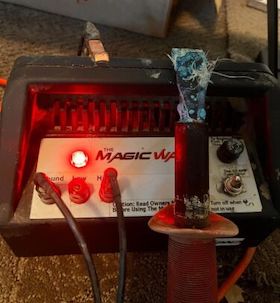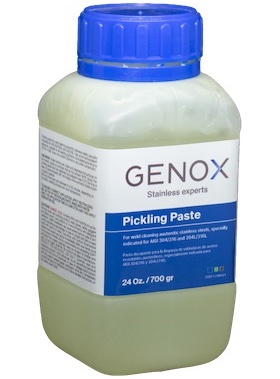
-----
Chemical to clean weld marks from stainless steel, or procedure to remove the burn marks?
Q. What is the fastest way to get rid of the discoloration that occur from the welding of stainless steel.
MIKE HUG1996
A. I use a 70/30 mixture of concentrated nitric/fluorhidric acids for a few minutes.
Miguel Flesia- Argentina

Never use HF anywhere unless trained!
If you do, you MUST have the antidote gel on hand for instant use!
Calcium Gluconate
for HF acid burns
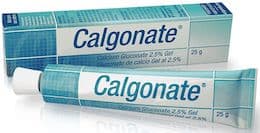
on eBay or Amazon
(affil link)
A. Beside the corrosive nature of the acid, the use of hydrofluoric acid in a hand operation to clean weld oxide is extremely hazardous as it is insidiously absorbed through the lungs and skin, causing permanent damage and death to internal organs.

Tom Pullizzi
Falls Township, Pennsylvania
A. From a poor mans standpoint, 50/50 hydrochloric acid is probably the quickest semi safe way to fix the problem. rinse well with warm water or it will rust later and or stain. Rubber gloves
⇦ on
eBay or
Amazon [affil link] swab and rub.
Fluoride is not that unsafe when you use ammonium bifluoride to get the fluoride content. By then it is so dilute that it is no more dangerous than the nitric acid is. 70% hydrofluoric is extremely dangerous until diluted and absolutely should not be used without extreme caution and by QUALIFIED TRAINED people only.
Polishing with a 410 SS wire rotary brush is a guaranteed way to have the area rust when exposed to high humidity.
- Navarre, Florida
1998
A. The best known way to remove heat generated discoloration off of stainless steel (any welded, laser or plasma or other heat generated method that causes it) is to use an electronic weld cleaner. Good luck and steer clear of those pastes, they are very very hazardous.
Glenn Mahonstainless steel fabricator - Los Angeles, California
2003
Multiple threads merged: please forgive chronology errors and repetition 🙂
Q. We are looking for safe and economical methods for finishing Stainless Steel after welding:
1) Removing weld discoloration
2) Regraining #4 Brushed Stainless
We are interested in chemical, electrical, electrochemical and manual methods. Most of our applications are low volume precision sheet metal components used in food or pharmaceutical equipment.
Brian Landsman- Chagrin Falls, Ohio, USA
2001
A. There are commercial products that should be available through a good welding shop for chemical removal of the oxidation around the weld. These pastes should be safe when handled carefully and supplied with directions and applicable warnings. My guess is that you will have to do some mechanical finishing to restore the original texture.

Larry Hanke
Minneapolis, Minnesota
A. Brian:
There is no "easy" way to do all you want to do, primarily the returning of the finish to #4 Brushed Finish. The best system we could recommend is to brush the surface of the welded area to remove the weld discoloration and return the surface to a semblance of the #4 finish with a ss wire brush or rotating brush on a drill or similar, followed by passivation with a proprietary citric acid to make sure the surface of the weld will not rust. Let us know if we can help.
Regards,

Lee Kremer
Stellar Solutions, Inc.
McHenry, Illinois
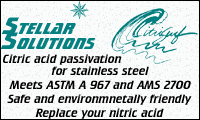
A. Try this combination Nitric - hydrofluoric acid combination. It will take some 5 minutes when you brush the welded part with tooth brush.
Hari Om!
- Mumbai, Maharashtra, India
2006
Tip: Readers are welcome to browse this site anonymously!
But its main purpose is to build worldwide camaraderie through sharing.
Those who believe in this might not engage with anonymous posters.
Multiple threads merged: please forgive chronology errors and repetition 🙂
Q. Is there any way to remove the blue/black marks caused by welding 304 2b stainless steel?
Thomas Sikoralighting - Chicago, Illinois, USA
2003
A. Pickle the weldments in 30% nitric, 5% hydrofluoric (rest water) at room temp for enough time to clean. You can opt for additional passivation in 30% nitric (no fluoride). Both chemicals are extremely dangerous and aggressive to all forms of life. Personnel protection, neutralization and disposal according to local laws is mandatory. Injectable calcium gluconate is also highly recommended to be available in case of possible skin contact with HF.
Guillermo MarrufoMonterrey, NL, Mexico
A. We use a product called Blueaway. It looks like runny toothpaste ... but requires very little effort. Not sure where we bought it.
Good luck,
- Lewisville, Texas
Multiple threads merged: please forgive chronology errors and repetition 🙂
Removing welding marks on stainless steel
Q. We are a kitchen manufacturing industry; we are using pickling solution (hydrofluoric acid + nitric acid ) for removal of oxide formed in the time of welding (TIG welding). In this process after some days of finishing, the chemical within the molecule of weld material reacts with weld material to form oxides.
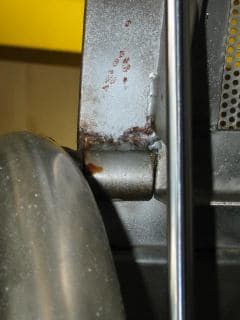
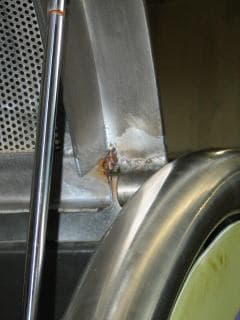
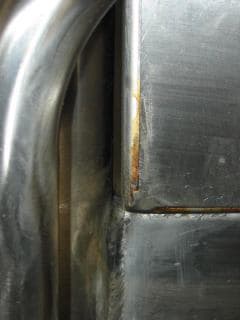
So please suggest another good process for this with proper solution.
Development engineer - Delhi, India
2007
A. Dear Pranabesh
You need to check the Welding Electrode -- what is it?
Are you using Arc Welding? -- Switch over to Gas Inert Welding.
Do not use chemicals to remove tinting of welded areas. Instead passivate them by simple grinding.
You must get in the habit of cleaning the component free from any residue of Chemical/Abrasive before selling it.
Hope this helps you.
- New Delhi, India
A. Sir, looking at the photos it appears as if you have contamination, either your filler rod is not pure or the process you are using is introducing contaminates.
We use TIG welding; either fuse the weld or if you have to add filler 308L wire (wire is cleaned prior to use, as is the joint area). Straight Argon or a Argon-Helium mix is used for the shielding gas.
Make sure your heat is not too great that you draw oxygen in from the rear of the weld (or run a gas purge behind the weld). This will avoid "crystalization" of the rear of the weld.
Hope this helps.

Andrew Benson
metal fab company (buyer)
Cocoa, Florida
A. Good TIG welds that are cleaned and chemically passivated afterwards will give good results. What alloy is this?
Grinding of the weld DOES NOT passivate it. Quite the opposite, it can easily cause ferrite formation that will rust later unless passivated chemically.

Lee Kremer
Stellar Solutions, Inc.
McHenry, Illinois

Multiple threads merged: please forgive chronology errors and repetition 🙂
Q. I work on a shop and we are starting to weld on stainless steel. I need to return its color to stainless steel after electric arc welding has been done. What can I use to return is color? I have been toll, that there is a product that you brush on the welds areas, wait some minutes, and then rinse with water. What is it? Where can I find it?
Thank you for your help.
shop employee - Miami, Florida, USA
2007
A. Carlos,
I have used a type of product called 'pickling paste' which is a gelled acid product. We bought it from a local weld supply house. Make sure you get a material intended for stainless steel. This product is dangerous to use if you do not follow the safety recommendations and do not use PPE (such as rubber gloves
⇦ on
eBay or
Amazon [affil link] , face shield
⇦ on
eBay or
Amazon [affil link]
, etc.). Also, if you use this material on a large area, you may need to be concerned about proper ventilation if you use this material on a large surface area. You might want to consider mechanical methods instead, such a using abrasives or glass beading.
- Erie, Pennsylvania. USA
A. Was anticipating the same problem. Found a product called BlueAway which is supposed to remove bluing from motorcycle pipes and stainless steel. Found it after a internet search at a motor cycle parts place for 17.99/2.5oz. Haven't tried it yet but may buy some.

Alan Heim
welder/fabicator, Greensboro, No. Carolina
A. Hi Carlos,
Pickling Paste can be used and you should be able to find it at a welding supply.
Micheline Forth
- Rincon, Georgia USA
A. There are three basic ways to remove the weld discoloration from the Heat Affected Zone.
A purely chemical removal takes harsh chemicals, typically a pickle paste as was previously mentioned, usually that is nitric-HF based.
Mechanical removal, i.e. grit blasting, grinding, polishing, buffing, etc.
Electrochemical removal, same basic principle aspolishing but applied locally to the weld where it is needed. A wand electrode can be rigged up yourself with your welder as a current source, and commercial units such as SurFox are also available. Let us know if you would like any help with this.

Ray Kremer
Stellar Solutions, Inc.
McHenry, Illinois

Q. I work for a tanker company my name is Bill, and want to know what I can use to remove the burn marks from welding. I need to find a chemical to use; it must look like it was not touched .
My boss is having me use a flapper wheel but I know that there is something that I can wipe it off with. Please if you can help. Thanks
welder - Lemoyne, Pennsylvania
2007
A. William:
Typical weld paste for pickling of welds will remove the heat effected discoloration (heat tint) that you see. It is generally a blend of nitric and hydrofluoric acid in a gelled solution. After removal of the heat tint, passivation should be performed with either nitric or citric acid gel passivation. These solutions can be purchased from a number of suppliers.
Thanks,
Costa Mesa, California, USA
Q. How do I get rid of burn stains left behind on a welded stainless steel?
nathaniel oitomenfabricator - benin, Nigeria
July 16, 2008
A. Try The Magic Wand from Diversified Products. It cleans weld burns quick and easy to use.
A. Martinez- Sunland, California
January 29, 2010
How to chemically remove weld seam marks from stainless steel?
Dear Sirs,
I'm WIG welding AISI 304 stainless steel. Is there some chemical (acid or something similar) to remove the change in color in the welded area?
Best Regards
hobbyist - Viseu, Portugal
August 19, 2008
A. Hi, Paulo. Yes, this generally goes by the name of 'pickling paste'. It usually involves the nasty acids hydrofluoric and nitric, so observe the MSDS carefully.
Regards,

Ted Mooney, P.E.
Striving to live Aloha
finishing.com - Pine Beach, New Jersey
Ted is available for instant help
or longer-term assistance.
adv.
Paulo, several appliance manufactures are using our Scratch-B-Gone kit to remove just this problem particularly at corner weld sights. Take a look.

Barry Feinman - Chief Restoration Officer
BarrysRestoreItAll
Carlsbad, California

A. Stainless wire brush right after welding.
Electropolishing will also remove heat discoloration and render the surface more corrosion resistant then passivation or pickling alone. It will also brighten the surface.
electropolishing shop - North Vancouver, British Columbia, Canada
Q. I remember using a product while working for another fabricator. It's a charcoal gray color with, what almost looks like glitter imbedded in it. It comes in a 2" X 3" X 1/2" block and feels alot like an eraser. It won't mar the surface and you use it like a sanding block. Is anyone familiar with this? I forgot the name of the maker.
Janet Emmert- Chicago, Illinois, USA
August 4, 2010
Q. Looking for a solvent that will take grinding burns off of hardened high speed steel.
brian a gillund- chicago Illinois
June 20, 2013
Q. Sir, I am doing a project in my college on stainless steel, to be more specific welding of stainless steel. We did some welding and that is my query: There are some weld marks on the jobs, which are not visually good. How can we remove those or you can say polish them out? Please help me out here sir. Thanks.
PRITAM BASU- ANDUL, WB, India
June 7, 2015
A. Hi Pritam. We appended your inquiry to an existing thread on the subject, which explains several different possible approaches. Good luck.
Regards,

Ted Mooney, P.E. RET
Striving to live Aloha
finishing.com - Pine Beach, New Jersey
Ted is available for instant help
or longer-term assistance.
Fabricating a stainless grille for a classic car
Q. Hi
I want to fabricate a grille for a 65 t-bird. I'm planning to use 304 stainless bar stock. The bars will be welded to form the assembly. I intend to polish each before assembly. My question is what will welding (TIG) do to the bars/finish? Will there be major discolouration? It may be very awkward to do full polishing after assembly, but minor touch ups should be possible. Any advice would be appreciated.
Thanks
Jeff
- Winnipeg Canada
September 25, 2016
A. Hi Jeff. We added your question to an existing thread about welding of 304 SS. The biggest problem is probably not how to clean the weld discoloration, but the fact that this is unlikely to be a satisfactory grill for an automobile in terms of staying attractive and rust free. If it's a show car kept in a garage and not used on the road, it's one thing; but environmental exposure on an automobile that is in use is rated "very severe" (as opposed to other applications which are rated mild, moderate, or severe). The 304 SS will probably rust even if passivated, and will surely rust if not. But good luck.
Regards,

Ted Mooney, P.E. RET
Striving to live Aloha
finishing.com - Pine Beach, New Jersey
Ted is available for instant help
or longer-term assistance.
Q. I weld thinner gauge stainless steel. After acid cleaning and fresh water rinsing, often times even with my best effort, there are seam leaks and acid residue left over on the finish that is very hard to permanently clean without a complete re-clean re-rinse, etc.
Is spray citrus oil cleaner an effective cleanup for that residue or do you suggest something different? A brand product would be most helpful.
SELF - Concord, North Carolina USA
September 27, 2016
A. Jeff,
Since you're in Canada I'm going to assume lots of salt on the road during the winter. I wouldn't try it with anything less than 316 that is electropolished and then citric passivated, and even then it would probably need occasional treatments to remove corrosion and repassivate.
Most car parts like that are chrome plated, I believe, and even then they don't often hold up forever to road conditions.
- - -
Jimmy,
I guess I'm not following you completely here. When you say acid cleaning, what type of acid? Liquid solution or some kind of gel/paste product? Acids are totally water soluble, so if your parts end up with dried acid residue on the surface it means your rinsing is not very good. Though sometimes people mistake acid etch marks for a "residue".
When you say seam leaks, what is leaking, and through what seams? The welds?

Ray Kremer
Stellar Solutions, Inc.
McHenry, Illinois

Q. How do I remove a burn mark or stain on my electric baseboards ?
John S. [surname deleted for privacy by Editor]- Toronto , Ontario , Canada
January 19, 2018
Hi John. A picture is worth a thousand words. Please send a pic to mooney@finishing.com.
Regards,

Ted Mooney, P.E. RET
Striving to live Aloha
finishing.com - Pine Beach, New Jersey
Ted is available for instant help
or longer-term assistance.
Q. Can we use Oxalic acid and phosphoric acid for removing weld marks from stainless steel?
Akshata GhadiRoyal arc gastech - Vasai, Mumbai, India
June 9, 2018
A. Akshata,
You can certainly try, but don't expect much success. Those acids generally are not powerful enough to etch heat discoloration from stainless.

Ray Kremer
Stellar Solutions, Inc.
McHenry, Illinois

Q. 32 years ago, when I picked up my new cycle from the dealer, I started it up (choke on), and was distracted by a friend interested in my new toy. Next thing I knew, he pointed to my stainless exhaust pipes, parts of which were glowing dark cherry red. I drove away to cool them down, but believe damage was done. I still own the bike, which is very rare, and highly sought after. The pipes have the brown discoloration (fairly easy to remove with Simichrome ⇦ on eBay or Amazon [affil link] ), but also spots, which require a lot of time with a buffer, and polishing compound. I have taken the pipes to mirror finish several times over the years, but once back in use, they quickly develop the dark spots. Unsightly. As the entire pipe gets stained, the spots are not very noticeable. My question is, is there anything I can do about this? Passivation or some heat treating process? Replacement parts are extremely hard to find.
Jim Canale- Homer, New York, USA
June 16, 2018
A. Hi Jim. The pipes should be passivated with citric acid based passivating solution after polishing. But I think (but don't know for sure) that getting them electropolished will deter both the brown spots and the general darkening.
I doubt that what you did 32 years and several mirror polishings ago is having any effect on what is going on today.
Regards,

Ted Mooney, P.E. RET
Striving to live Aloha
finishing.com - Pine Beach, New Jersey
Ted is available for instant help
or longer-term assistance.
Q. Ted,
Thanks for your reply. Is this citric acid passivating solution something I can cook up myself? If so, how is it formulated, and what is the process? Or is it something I must go to a plating house for? I take it electropolishing IS something that needs to be done by a professional.
- Homer, New York, USA
A. Hi again. You can apply the citric acid yourself, but I would advise buying it as a proprietary so you get the right stuff at the right concentration, as well as the necessary instructions. I can suggest contacting Stellar Solutions [a finishing.com supporting advertiser] about it.
You cannot do electropolishing yourself. You would have to send the pipes out to an electropolishing shop. Good luck.
Regards,

Ted Mooney, P.E. RET
Striving to live Aloha
finishing.com - Pine Beach, New Jersey
Ted is available for instant help
or longer-term assistance.
Q. Hi
Is there any economical way to clean large size structures of a 3 metre size of SS 304 material having heavy TIG welding black marks? Every month we need to clean 45 structures after buffing the external surface.
Fabrication - Hyderabad, India
March 31, 2019
A. Haribabu,
Normally mechanical descaling like bead blasting or wire wheel grinding, or some sort of pickling paste.

Ray Kremer
Stellar Solutions, Inc.
McHenry, Illinois

Q. Hello ... I have been reading some of the questions and answers to the discoloration of stainless steel from heat. I have been approached by a fabrication shop that welds stainless steel. They wanted to see if I can get rid of the discoloration from where they weld at without abrasion. They have been having it sandblasted with a very fine sand but that's not what they're wanting. What way if any is the best way to remove the discoloration without leaving a profile? Thank you.
Timothy Miller- LIMA, Ohio..... United States
October 31, 2019
A. Google "Pickling Paste" - Apply, let stand, rinse off.

Jeffrey Holmes, CEF
Spartanburg, South Carolina
Q, A, or Comment on THIS thread -or- Start a NEW Thread

